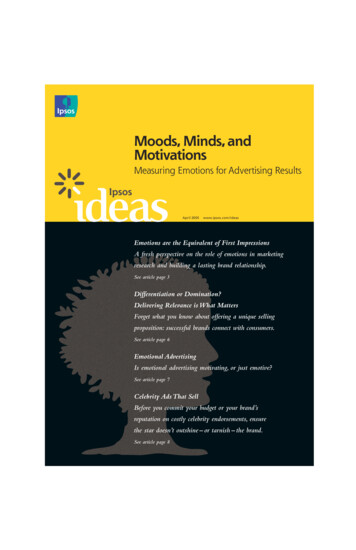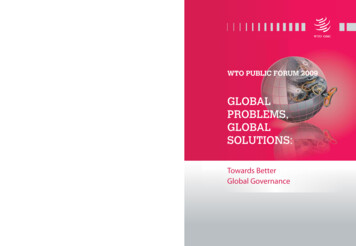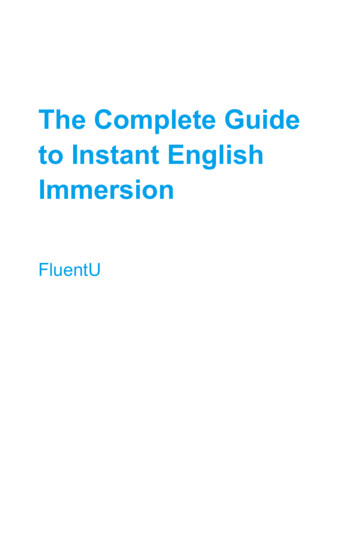
Transcription
04.12.65.Global English v43/17/0510:08 AMPage 1Moods, Minds, andMotivationsMeasuring Emotions for Advertising ResultsApril 2005www.ipsos.com/ideasEmotions are the Equivalent of First ImpressionsA fresh perspective on the role of emotions in marketingresearch and building a lasting brand relationship.See article page 3Differentiation or Domination?Delivering Relevance is What MattersForget what you know about offering a unique sellingproposition: successful brands connect with consumers.See article page 6Emotional AdvertisingIs emotional advertising motivating, or just emotive?See article page 7Celebrity Ads That SellBefore you commit your budget or your brand’sreputation on costly celebrity endorsements, ensurethe star doesn’t outshine – or tarnish – the brand.See article page 8
04.12.65.Global English v423/17/0510:08 AMPage 2Ipsos IdeasOn Your Marks,Get Set, Stop! By Jean-Marc Lech“Nobody’s unpredictable.”Ipsos’ tagline proclaims itlike an incantation. And yet,consumers are increasinglyfickle: channel-surfing iswidespread; buying habits,attitudes towards socialissues, even the opinionsexpressed at home and inthe workplace changefrequently, shifting less atthe whim of fashion thanwith their evolving desires.Marketing experts – whosejob is to build stability, thegreatest possible balanceimaginable – are beingdriven mad by widespreadbrand promiscuity.Ads reflect this disarray.Leaving the brand behind,they focus instead onthe product’s technicalinnovations. But beware ofconfusing the brand andits packaging. If the brand isthe surname, the packagingis its common and usualname.The mad dash for newand improved productsnever ends: between rivalbrands, anything canbe duplicated. Technicaladvantage is fleeting.In the face of shorter shelflives and a greater numberof available goods andservices, the answer is togrow established brands inmore stable territories:transgressing or regressingthe brand, for example.But in the rush to market,the shortest distance isn’talways a straight line:one risks jumping the gunand losing the race. At theend of the day, the wearyconsumer is overloaded byads and their offers.It’s high time to go backto advertising brandson the ultimately morestable and universal basisof the human psyche:maximising pleasure!About Ipsos IdeasIpsos Ideas is published by Ipsos,a leading global survey-based marketresearch company. Current and pastissues of Ipsos Ideas are available atwww.ipsos.com/ideas.To receive a free email subscription,to send us your comments or questions,or to unsubscribe to the newsletter,please email charlotte.vigne@ipsos.comor write us at:Ipsos IdeasCommunications Department35 rue du Val de Marne75013 Paris cedex 13, FranceTel: 33 1 41 98 90 00Fax: 33 1 41 98 90 50PublisherJean-Marc LechEditorial Board MembersJean-Marc LechJohn HallwardDave WalkerEditorial TeamDan MaceluchCatherine RoussièsCharlotte VigneErin WilliamsProductionRoland CliffordBarbara DayMarketingElen AlexovDarcy Ulmer 20 05, Ipsos. All rights reserved.Past publications:January 2005: “Krisis: The NewQualitative Approach from Ipsos”November 2004: “Secure the Successof Your Brands”October 2004: “The Faces ofPolitical Seduction”February 2004: “The New Era ofCustomer Relationships”September 2003: “Opinions ofthe War, and the War of Opinions”May 2003: “Advertising:Money Down the Drain?”Jean-Marc Lech is Co-President of Ipsos and has worked alongside Didier Truchot since 1982. A specialist in the public opinion field,he started his career in 1970 with IFOP (Institut Français d’Opinion Publique) of which he was made Chairman and Managing Director in 1980.He has published a number of works relating to French society and politics, the most recent of which was entitled Sondages Privés (Private Polls).Contact: jean-marc.lech@ipsos.com.
04.12.65.Global English v43/17/0510:08 AMPage 3Ipsos IdeasEmotions are the Equivalentof First Impressions By John HallwardEmotions, like first impressions, are important because they influence the responses andbehaviour that follow – and they may determine whether anything follows at all. Sincethe first impressions of advertising may often be more emotional than rational, we needto explore beyond the rational to better understand consumers’ emotions towards andimpressions of the product or the message.This article shares our journey to discoverwhat drives consumers’ motivations to buyone brand versus another. To be clear, it isnot our aim to join the interesting discussionson the theories of human emotions, norto debate what is an emotion, why we havethem, and so on. Instead, we are lookingfor practical ideas that we can use in ourresearch tools to better understand the whybehind motivation, and, in turn, help ourclients better understand how to motivateand to persuade.Hiding First ImpressionsIf you ask a consumer why they buy aparticular brand, the respondent is mostlikely to talk about rational features andrational benefits of the product or service.The respondent provides conscious, cognitive responses – which are likely guarded,socially acceptable, and safe. The respondentwill also likely use cognitive thinking toprovide expected answers to try to helpthe researcher.What the respondent will not likely do sowell is describe his or her personal drivingmotivations, emotions associated with thebrand context, unconscious thinking, values,and aspirations. Often, respondents arenot aware of all their emotions, and struggleto voluntarily describe them. Additionally,some emotions are personal and perhapsembarrassing to admit aloud. Furthermore,the respondent might not care to mentionall of their feelings, since some of theseemotions may not be directly related to thebrand characteristics. We have also noticedthat many respondents do not know howto answer when we ask them to tell us whythey bought one brand versus another.Emotions MatterDespite the exact definition of what anemotion is, or what a feeling is, it is nowwidely accepted that emotions regulate,influence, and even organize our behaviour.Subconscious emotions mediate ourattitudes, bias our cognitive thinking, anddrive our desires. Emotions transformour perceptions and our experiences withproducts and services and can build associations to brands. In short, emotions influenceour disposition to buy brands. Therefore,emotions are important in understandingwhy consumers buy what they do. Frankly,people’s emotions may be so influentialthat they are more important than whatthey say.Emotions are ComplexThe simplest thing to say about emotionsand motivational drivers is that the brainworks in mysterious ways.We have discoveredthat emotions are not easy to define andthey do not operate independently. Emotionsrepresent a complex set of interactions.Some things that appear to be feelings aren’tnecessarily so: just because one can say,“I feel hungry” does not mean that hungeris an emotional state (it is a physical state).Nonetheless, for advertising research purposeswe are happy to accept some states thatmay be more cognitive than emotional,such as “confusion” or “doubt.” Since a maincomponent of advertising is promise, it isuseful to include “doubt” in our work aboutfeelings and emotions.Emotions can be observed as a physiologicalcomponent (for example, an increasedheart rate), an expressive component(facial display), an experiential component(subjective feelings which the person canrecognize and describe), and, eventually,a behavioral response (for example, kickingthe ground in frustration). Owing to thesensual characteristics of emotions, it appearslogical to try to measure emotions vianon-textual measures, such as physiologicaldetectors (ECG, skin response, heart rate).But physiological detectors do not describenor identify why the body is respondingthe way it is (a heart rate can increase formany opposing reasons). Since the bodyexpresses and responds to emotions anddisplays emotions, humans can interpret thisbody language. Thus, it is logical to usegraphics in our research that relate to facialand whole-body expressions.It requires several expressions to understandand describe emotions. For researchpurposes, it requires a balance of not toomany emotional descriptors, and nottoo few, which might not be descriptiveenough. We likely want to avoid usingsemantic differential scales because the lackof one emotion may not relate to theexistence of an opposite or other emotion:emotions interact and they are not simplistically summarized in a few fixed scales.Designing a Research Tool for EmotionsSo where does this lead us? As part ofour research and development efforts atIpsos-ASI, we focused on generating amanageable list of emotional states. We alsohired two independent artists to try toillustrate these various emotions. To cut along, detailed research story short, weconducted several phases of consumerresearch to understand how the variousemotions related to each other and to checkhow well the artists’ drawings representedthese emotions. Eventually we arrivedat a map of emotions based on consumers’Continued 3
04.12.65.Global English v443/17/0510:08 AMPage 4Ipsos IdeasEmotions are the Equivalent of First ImpressionsEmoti*ScapeTMApathetic/UnmovedAt ertained/PleasedTired/Worn OutSad/DepressedCool/CalmBoredJealous/WishfulWarm us/OutragedEager/Enthusiastic Ipsos 2005insights. We call this emotional map ourEmoti * Scape,TM and we use it to helprespondents reflect their emotional feelingstowards brands and towards advertising.Our data proves that this tool discriminatesbetween brands and between ads. We alsoconfirmed with respondents that theseemotional graphics were easy to understand,and that they liked using this approach.We separately assessed many of the same adswithout the Emoti * Scape by asking theexact same questions of respondents usingopen-ended questions. As one can imagine,the open-ended, volunteered responseswere less robust, less specific, and not asinsightful as the responses gained usingthe Emoti * Scape.Which Emotions to Measure?Advertising, as well as all of marketing, cancreate emotional associations for a brand.But the soul of marketing, and particularlyadvertising, is to motivate and to persuade,not just create emotions. For assessingadvertising and why the advertising is or isnot working, it is important to understandhow emotions influence brand motivationand sales. That is, measuring emotions aloneis not enough in understanding why weobserve the brand behaviour (sales) thatwe do. Emotions are only one step in thebigger process of understanding motivationand behaviour.So now we have an emotions landscape,Emoti* Scape,TM but what emotional questionsdo we want to ask? For advertising, wesettled on two distinct questions, and weadded a third for the brand:1. What feelings do you have from this ad?2. What feelings is the advertiser trying touse and portray within the ad?3. What emotions do you associate withbeing a brand user?We ask respondents to indicate where onthe Emoti * Scape best represents theirfeelings for each of these three questions.Going Beyond EmotionsJust because a consumer feels curious orfeels appreciated, it does not fully explaintheir behaviour: is the consumer curiousand he or she wants to try the product(because it is fun to try new things), or is heor she equally curious but not likely tobuy the product until they hear what otherssay about the brand (because they are riskadverse)? It appears that emotions runthrough a consumers’ personal filter of theirvalues, needs, desires, memories, aspirations,and so on.Emotions appear to open consumers to a setof possible responses or outcomes (positiveemotions tend to open a different set ofoutcomes than negative emotions), but thespecific outcome within the set is explainedby going beyond the emotions, to includepersonal values and self-interest drivers.In a general sense, these values and driversbuild from the basic physical needs wehave for food, sleep, sex, and so on, and takeus into the less tangible more emotionalneeds and desires (such as self-esteemand self-actualization).
04.12.65.Global English v43/17/0510:08 AMPage 5Ipsos IdeasPersonal Values That LeadOur MotivationsFor personal values, we conducted anextensive review of personality traits: traits,in particular, which explain behaviour.We conducted R&D, and settled on elevenclusters of different personality types.These explain brand purchase intent anddiscriminate between choices of brandsand responses to advertising: Social, outgoing, extroverted Emotional, touching, sensitive, feeling Reserved, quiet, introverted Spontaneous, creative, impulsive Involving, consensus-oriented,harmonious Assertive, in control, decisive Independent, individualistic Selfless, giving Rational, practical, organized Conservative, traditional Progressive, innovativeIn our data, we have learned that the moreconsumers associate these personal valuesto a brand, the higher their motivation is tobuy the brand. This is also observed withinbrand users. We also asked consumers toscore themselves for these personal traits anddiscovered that the closer a brand matchesthe person’s own view of themselves, thehigher that consumer wants to buy the brand.That is, consumers tend to be motivatedtowards brands that match how they seethemselves, and it is more important thanwhat they aspire to be (as proved by aseparate unsuccessful R&D track wefollowed). Thus, these personal values tendto explain brand purchase interest and aremore useful than looking at emotions alone.Self-Interest Emotional DriversPeople do not always act in a predictablemanner. For example, introverted people donot always buy introverted products, or dointroverted things. From time to time, theymay act in extroverted ways. Each person hasdifferent levels of desires (what they want),and people’s desires ebb and flow dependingon what they do from day to day. The morea person wants to realize an emotionalpay-off, the more likely they are to respondor act to get it. These desires, once activated,drive motivation.For example, each of us has a uniquespecific equilibrium or balanced level forhow much excitement we want in ourlives. If we have a long, hard work-weekwithout much excitement in our lives,then this element gets out of balance(the excitement level starts to run down).In turn, we look to rectify this by searchingout something fun and exciting, or wewill respond more favourably to a choice orstimulus that promises to deliver fun andexcitement. What satisfies each of our needsfor excitement likely differs. Conversely,after a fun and exciting weekend, we mightbe over-balanced and wish to avoid anotherexciting event so soon. Instead, we mightwish to top up our level for harmony andfitting in with others, or to search outtraditional family time.Thus, it appears that we can enhance ourunderstanding of brand motivation byalso looking at self-interest drivers (suchas excitement, harmony, possession ofprestigious things, and so on). After extensivereading, Internet searches, and more R&Dwith consumers, we settled on a consensusof eleven buckets of drivers. These arefelt to be universal and they represent selfinterest emotional desires that we all want(to greater or lesser degrees). To increase our safety, security, or makeour life less risky (to avoid problems). For fun, excitement, or somethingdifferent (a novelty).Like for personal values, we discoveredthat these self-interest drivers discriminatebetween brand associations and betweendifferent ads. We found that asking bothpersonal values and self-interest driversallowed us to better explain brand purchaseinterests than using one set of measures.Thus, these self-interest drivers are alsoimportant in explaining and achieving brandmotivation. Our data shows that there isa direct, statistically significant correlationbetween an advertisement improving abrand’s relation to these drivers and theincreased interest to buy the brand.In closing, our Emoti * Scape, personal valuesmeasures, and self-interest drivers mayappear somewhat simplistic in light of thecomplexities of our brains, but these newtechniques are proving to be discriminating,insightful, and helpful.These new measuresare exposing a different part of motivationalinsight, which is missing from the standardopen-ended questions. We are encouragedby our findings and we are pushing on withbringing our work to market. We alsocontinue with the natural next steps ofthis R&D programme.Your feedback andcomments are certainly welcome. It is prestigious for people (somethingspecial to own). “Look at what I have.” To be self-sufficient, independent,autonomous. To be in better control of our lives. For the appreciation or protection ofothers (or nature). To experience personal success orachievement (ego). In respect and acceptance of our culture& community (traditional values). For a pleasurable sensuous feeling. To affiliate with others.To beharmonious.To fit in. Consensus. For greater efficiency and an easier life.For practicality.John Hallward co-founded Tandemar Research in Canada in 1986, after working at Procter & Gamble and Johnson & Johnson. Tandemar joinedthe Ipsos Group in 2000, and was aligned with Ipsos-ASI to specialize in advertising research. John is now responsible for product developmentwithin Ipsos-ASI worldwide, focusing on copy testing, Equity*Builder for brand health, in-market tracking, and now emotional/motivationalmeasurement. Contact: john.hallward@ipsos-asi.com.5
04.12.65.Global English v463/17/0510:08 AMPage 6Ipsos IdeasDifferentiation or Domination?Delivering Relevance is What MattersOften we hear that the role of marketingis to offer the brand with a USP – a uniqueselling proposition – and to point to theproduct features or characteristics as the“reason to believe.” But this is the perspectiveof the brand manufacturer, in competitionversus other brand choices. What abouta consumer-focused approach? For theconsumer, the decision to buy one brandversus another is about “what does itdo for me?” at the personal, emotionallevel, with little regard for all the (similar)brand features.If emotions, personal values, and self-interestdrivers are the fundamental basis for ourmotivations, then why a consumer buyssomething may or may not be about theproduct features or differentiation. Manyconsumers buy brands because of their desireto fit in and harmonize. From our brandequity database and Equity*Builder,TM weobserve that (1) popularity is a key ingredientin many brands’ success, and (2) relevanceis more important than just being unique.What happens when many of the leadingbrands are similar in characteristics, features,and price? Isn’t this the challenge in somany mature categories today? Price brandsand private label products are often goodenough for consumers, challenging thebrand leaders. Many brands in each categoryare quite similar in product function andcharacteristics. Is there much productdifference within the top bar soap brands,detergents, battery brands, cheese brands,or car rental companies? The concept ofdifferentiation no longer has the attractionit might have once had.The solution is to focus on the consumerand his or her emotions, personal values,and self-interest drivers, and worry less aboutbrand characteristics and USPs.The goalis to add emotional associations andself-rewarding pay-offs for using a brand.Good product performance might be theprice of entry, but brand empathy is realizedwhen the brand satisfies personal emotionaldesires. In the chart below, we see that justlooking at personal values and self-interestdrivers alone, we can explain 10% – 35%of the variance for future intent to buy thebrand, notwithstanding any considerationBy John Hallwardfor pricing, product performance, packagingfeatures, distribution, and marketingprogrammes. This supports our view thatemotional associations can positivelybias brand purchase interest.Number of ‘Self-Interest Drivers’attributed to brand(among brand users: American data)Definitely will buy brandDefinitely/probably will buy brand81%76%66%56%44%39%1–2 self-interestdrivers associatedwith brand3 – 4 self-interestdrivers associatedwith brand5 – 6 self-interestdrivers associatedwith brand Ipsos 2005The more successful brands – those withstrong brand empathy – appear to be able tooffer many emotional associations anddrivers. It is not about owning just one setof emotional associations, but offeringmany. In our data, we observe that the moreself-interest drivers a brand can be associatedwith (that is, the drivers the brand scoreswell on), the higher the purchase interest tobuy the brand.Some big equity brands can offer manyemotional pay-offs, even in what appearto be opposing ways. Consumers can seea brand offering both associations of extroversion, individualism, and showing-off,while at the same time offering associationsof introversion, harmony, and being social.Other brands may be void of such emotionalassociations all together (empty brands,weak on emotional pay-offs). By offeringmany emotional pay-offs and associations,a brand can make itself more appealing andmore relevant. The more types of emotionalpay-offs a brand can offer or satiate, themore times it can be relevant to eachconsumer, whatever his or her mood ordesire. The optimal way for a brand to growand to have a lot of appeal is to create andoffer emotional pay-offs: to be “all things toall people” on a personal emotional level.This is not likely a surprise nor contradictory. Consider the favourite people inyour life: do they offer you just one or twostrong emotional or personal benefits,or do they offer many different emotionalor personal associations?Purchase Intent by ‘Personal Values’ and ‘Self-Interest Drivers’Mercury (auto)Ford MustangAudiViagraPanteneVisaAmexCheeriosSpecial KHeinekenBudweiserBen and Jerry’sHaagen Dazs0%10%20%30%% Variance Explained (adj R2) Ipsos 200540%50%60%
04.12.65.Global English v43/17/0510:08 AMPage 7Ipsos IdeasEmotional AdvertisingBy John HallwardIf we accept that emotions influence ourdesires, motivations, and behaviour, thenit makes sense to consider the role ofemotions in advertising. After all, the raisond’être of advertising and marketing is topersuade, motivate, and sell. So creating theappropriate emotions in advertising islikely to have a positive effect on persuasion.But does this mean that emotional advertising is persuasive? And in what ways is itpersuasive or not persuasive?All advertising creates an emotional response.This is basic, instinctive, and normal. Eventhe most dry and communicative ads canevoke some interest, curiosity, or desire. Thechallenge for advertisers is to distinguishbetween the emotional content of thecreative and the viewers’ emotional responseto the creative. The latter is far moreimportant. It is ineffective to have a warm,emotional ad if this does not provide afavourable emotional association to the brand.We all recognize the pitfalls of advertisingthat is entertaining, but fails to sell the brand(directly or indirectly). This can happenwhen the focus of the ad is on emotionswithin the ad instead of focusing on theemotions associated with the brand.The good news is that ads that do createfavourable emotional responses have greaterad recall potential and also greater persuasion.(By recall potential and persuasion, werefer to the measures in Ipsos-ASI Next*ad pretests; and by emotional responses,we refer to our new Emoti*Scape, whichis used in our ad pretests.) Specifically,we see that ads that increase brand associations for “emotional, touching, sensitive,and feeling” correlate more strongly withpersuasion (versus ads that make a brandrational, practical, and organized). This isconsistent with the many published viewsabout how great brands create experiences,and how great brands emotionally touchpeople. Advertising that improves brand“Emotions Towards Ad” by PersuasionPositive Persuasion Ads (n 3148)Negative Persuasion Ads (n 856)30.4% emotional response13.5% emotional response2.3%1.2%2.9%1.2%Warm FuzzyCurious/InterestedHappy Ipsos 2005perceptions of “pleasure, sensuous, an easierlife, and appreciation or protection of others(or nature)” tends to be more persuasive.In our brand equity research (conductedseparately from ad testing), we see manyparallels. Brands that have created strongeremotional and personal associations tendto have higher purchase interest.Engaging the consumer and getting afavourable emotional response is only thebeginning of the motivational process.Ads that only create “good, happy, warm,and fuzzy” emotions and fail to engagethe consumers’ interest or curiosity are likelyto be weak in persuasion. If an ad cangenerate feelings of curiosity or interest,it is much more likely to be successful.Some ads can score strongly for “happy,warm, and fuzzy” but still fail to persuadeor motivate a change in behaviour.Conversely, some ads that stir curiosityare quite persuasive without being warmand fuzzy.In summary, developing emotionalassociations for a brand is a powerful tooland can increase brand motivation, butthe advertising must also engage the viewerby creating curiosity and interest.Advertisers should be very cautious aboutads that are simply happy, warm, and fuzzy.7
04.12.65.Global English v483/17/0510:08 AMPage 8Ipsos IdeasCelebrity Ads That SellBy Dave WalkerAround the world, television advertisersuse celebrities or stars in a bid to winconsumers’ attention, interest, and favourableattitudes toward their brands. Advertisershave employed famous athletes, actors,musicians, and even political figures.Does it really work? Sometimes it does:successful celebrity campaigns are famous.Sometimes it doesn’t: David Ogilvy reportedmany years ago that, in his experience,“Testimonials by celebrities are belowaverage in their ability to change brandpreference.Viewers guess that the celebrityhas been bought, and they are right.Viewershave a way of remembering the celebritybut forgetting the product.”On the whole, our experience confirmsOgilvy’s opinions. We find that ads featuringcelebrities are no more likely to succeedthan other creative strategies, and they riskfailure due to the problems he cites.Yet our research also illuminates the factorsthat differentiate success from failure,and can guide advertisers to use celebritiesmore effectively.The risk, as Ogilvy said, is that the star mayovershadow the product and the message.The obvious solution is to make sure thatthe ad and the celebrity are focused onthe brand or product. A less obvious findingis that successful celebrity ads clearly identifyboth the brand and the star. If the celebrityis not identified in the ad itself, viewers maybe distracted with their own questions(“Who is that? Is it really ?”). Evenwhen the star is well known, ads that identifythe celebrity in both audio copy and onthe screen demonstrate greater persuasivenessand branded recall than ads that rely onthe star’s recognition alone. Having paid forthe name, the advertiser is well advised toinclude it in the message.Visual Only (24 ads)Both Audio & Visual (9 ads)Related Recall79%91%99%103%Measured Attention108%105%119%100%Making the Most of Name RecognitionPretest scores from North America, LatinAmerica, and Europe show that, on average,celebrity ads score below norm on keymeasures of persuasion and branded communication (related recall).While celebritiesmay generate higher levels of attentionamong viewers, the impression is not alwaysstrongly linked to the advertised brand.Linkage Ratio74%87%86%106%Persuasion63%77%84%95% Ipsos 2005Source: Next*TV US, scores indexed to local normsAverage Score for Celebrity AdsUSEuropeCredibility and Relevance Are CriticalLatin AmericaAd-Related Recall91%88%100%Measured Attention (Recognition)106%94%103%Brand Linkage88%92%99%Persuasion80%97%94% Ipsos 2005Source: Ipsos-ASI Next*TV, scores indexed to local normsAverage Score for Celebrity AdsBelievability86%Relevance93%Differentiation94% Ipsos 2005Source: Next*TV Europe, scores indexed to local normsChoosing and Using Celebritiesfor Effective AdsAverage ScoreCelebrity Identified in Ad?No (9 ads)Audio Only (9 ads)debonair movie star for a whiskey. Themessage becomes more powerful when thecelebrity endorsement carries “expert”authority or relevance for the brand, suchas an athlete for sportswear or equipment,a famous chef for a food product, or aracecar driver for tires or motor oil.Another finding from our research is thatcelebrity ads often achieve lower ratings notonly for believability, as Ogilvy suggested,but for relevance and differentiation as well.Relevance and credibility depend on howthe message and the product fit with thestar’s persona, and how these elements arerelated in the ad. In the simplest form,the ad may associate the brand with a star’simage (either as a public person, or in afamiliar role) as a direct or implied endorsement. Classic examples would be a glamorousactress or model for beauty products, or aWhile the findings described here comefrom television ad research, the principlesapply to celebrities in any medium. Theseprinciples also appear to work acrosscountries, but a given celebrity campaignmay not, so international campaigns presentadditional challenges. A few stars transcendcultural boundaries: Pepsi is reported tohave increased its global market share withTV campaigns first featuring MichaelJackson and, later, the Spice Girls, eachcontributing to an image of youthful vitalityand universal popularity for the brand.Even a star that is internationally famousmay have a different image or reputationin differen
people do not always act in a predictable manner.for example,introverted people do not always buy introverted products,or do introverted things.from time to time,they may act in extroverted ways.each person has different levels of desires (what they want), and people's desires ebb and flow depending on what they do from day to day.the more a











